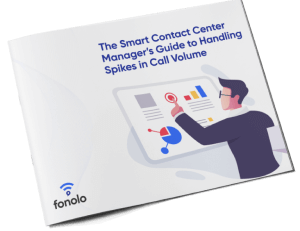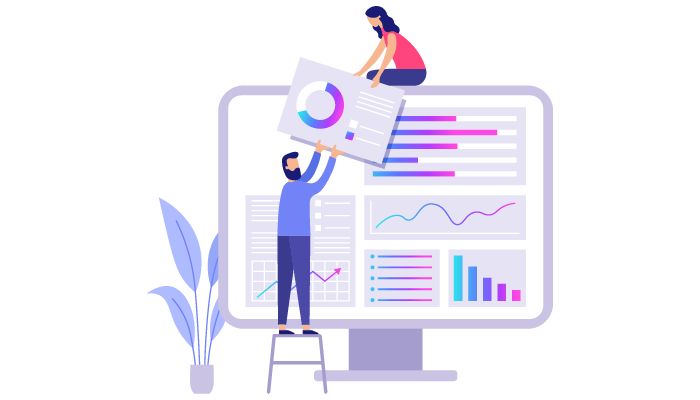Picture this: you’re packing for an upcoming camping trip. To make sure you have everything you need while you’re in the woods, you check the weather forecast. Depending on the temperature and precipitation predictions, you may pack completely differently than expected.
Take this practical scenario and apply it to a contact center—and what’s the result? Something called call center forecasting. Although we’re not saying you need to check if it’s going to rain in your call center next week, we are 100% certain that it’s best practice to try to predict future events to ensure you and your staff are always prepared to weather the best and worst of conditions.
3 Reasons Why Call Center Forecasting is Important
There are many benefits to maintaining an accurate forecast, but we’re going to focus on the top 3. Correctly forecasting your volume of calls can help:
1. Significantly cut staffing costs.
Ensuring you have the right amount of contact center agents at the right times means you won’t waste money by accidentally over-staffing on quieter days.
2. Increase agent retention.
When enough agents are scheduled during the busiest times, staff can still take the breaks they need to prevent burnout. They’ll also feel properly supported even when other team members are on vacation or need to call in sick for a day or two. Put simply, forecast accuracy leads to better workforce management.
3. Improve Customer Satisfaction (CSat) scores.
Nothing makes a customer happier than having their call answered with hardly any wait time in the queue. Accurate forecasting ensures customer’s queries will be answered promptly, encouraging them to leave higher scores on their CSat surveys.
DID YOU KNOW:
Another way to improve CSat scores is by investing in call-back technology like Fonolo’s Voice Call-Backs. Customers will be asked if they would prefer a call from an agent when it’s their turn in the queue, giving them the flexibility to continue with their day, and with no waiting required.
How to forecast like a pro
Although there isn’t one simple way to analyze data and forecast for your call center, there are some best practices around setting your contact center up for forecasting success.
Know which numbers are most important for forecasting.
There are three main KPIs you need to keep in mind while forecasting. First is the most obvious one: call volume. This number indicates how many calls you received during any given period. Second, you’ll want to look at average handle time: the amount of time it takes for an agent to complete a call from the moment they answer to the moment they finish their post-call tasks. Lastly, consider your service level goal, or the objective you’ve set for how many calls get answered in a certain number of seconds or minutes.
Collect historical data.
To begin your forecasting journey, take a peek at historical data from the last couple years. Go through daily, weekly, and monthly numbers and search for patterns. For example, it’s common to see call spikes on Monday mornings if you’re closed or work limited hours on weekends. Retail contact centers will notice an increase in activity during the months leading up to major gifting holidays like Christmas or Valentine’s Day. Write these patterns down to simplify future forecasting.
TIP:
It may be easier for you to break forecasting down into two categories: long-term and short-term. Long-term forecasting will have you analyzing historical data from the last few years and proactively developing plans based on those numbers. Short-term forecasting will have you looking at the last few months to determine your next steps for the weeks to come.
Choose your forecasting method or model.
A forecasting method is the technique you’ll use to create your forecasting plan. Some common models include:
- Averaging – this takes the average number of calls for any given period and applies it to your future scheduling.
- Point estimate model – this assumes days will see similar call volumes as they did in the past.
- Triple exponential smoothing – this splits forecasting data into 3 components: levels, trends, and seasonality. Then, it “smooths out” or finds the average of each.
Call center managers will often adopt more than one forecasting method—opt for whatever you think best suits the needs of your call center.
Create your forecast.
Now that you have some data and have decided on a single or hybrid model, you can go ahead and start forecasting. You’ll likely be calculating formulas in Microsoft Excel sheets; from there, you can record your findings in a program like Word to save for future analysis. Keep in mind that you’ll need to have collected a minimum of two weeks’-worth of data to properly forecast for the next few days. The farther back you can go, the farther ahead you can forecast.
FACT:
There’s a myriad of forecasting technology available that can analyze your data in a snap. This is particularly helpful for older and larger-sized call centers that have an overwhelming amount of historical data in their back pockets.
Apply your forecasting to every channel.
Don’t just stop at call forecasting. Now that other channels like online chats are being utilized in most contact centers, be sure to include these in your forecasting and scheduling as well. On heavier volume days, consider having agents who are dedicated to working through online chats only. On quieter days, save some money on staffing by having agents monitoring both the call queue and chats.
Take action.
Once you’ve created your forecast, it’s time to put your money where your staff is (or should be). Start creating schedules that reflect your forecasted call volume. If you predict that a day or a week will be on the quieter side, schedule less bodies. Quieter days are also great training days for new staff, as they’re less likely to get overwhelmed and trainers will have more downtime to teach.
If it looks like you’re going to have an extremely busy day, we recommend scheduling a greater number of agents who have a higher level of experience. They’ll be able to get through calls more quickly than newer staff and ensure all the customers leave their interactions feeling cared for as opposed to rushed.
Continue to refine your methodology overtime.
Your forecasting strategy and methods should always be in a constant state of flux. The more you forecast, the more you’ll learn. Every time you sit down to forecast, take your learnings from previous sessions into account, and tweak your plan of attack.

How to Manage Call Spikes in the Contact Center
Download this free guide to learn how to protect your contact center from call spikes.
